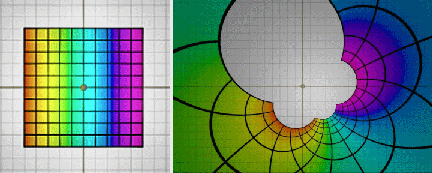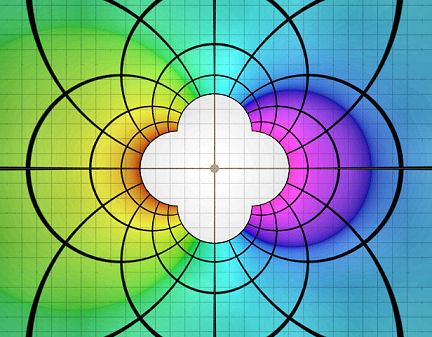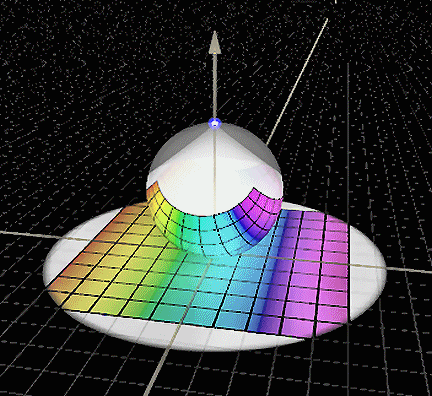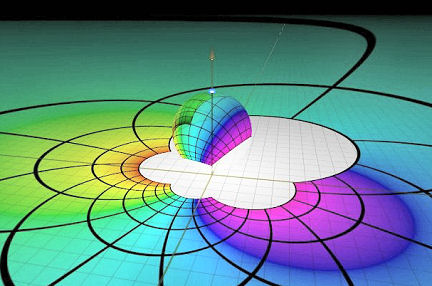Science News Online |
|||||||||
A Video That's Worth a Million WordsAward-winning video reveals the simplicity and beauty of an abstract mathematical toolJulie J. Rehmeyer Abstraction lies at the heart of mathematics. It makes math powerful, but at the same time, it can make math hard to understand. Abstraction makes math simultaneously beautiful and austere, useful and esoteric. But a picture can tame the mad monster of abstraction, and sometimes, a video can do so even better. Now, a pair of mathematicians has created a video (see http://www.youtube.com/watch?v=JX3VmDgiFnY) that shows how to visualize and understand Möbius transformations, which are a fundamental and highly abstract mathematical tool. The new video, "Möbius Transformations Revealed," has become an Internet sensation, with 60,000 hits on YouTube so far. It also won honorable mention in the Science 2007 Science and Engineering Visualization challenge. A Möbius transformation begins with a plane and moves each point to a new location according to certain rules. In their video, Douglas N. Arnold and Jonathan Rogness of the University of Minnesota in Minneapolis transform a multicolored square into new shapes using Möbius transformations.
A Möbius transformation alters an entire plane. To understand the transformation, it helps to focus on a square that lies on the plane. A Möbius transformation can alter the square in any of four ways. The first three ways aren't too hard to picture: the transformation can move a square around on the plane, expand or contract the square, or rotate it. The fourth alteration is especially intriguing. A Möbius transformation can turn the square inside out. The Arnold-Rogness video illustrates this process beautifully, showing how points that start close to the square's center are sent far outward, while points near the edge of the square move toward the center.
Next comes the video's magical step. The mathematicians move into the third dimension to provide a way of visualizing the Möbius transformations. They suspend a sphere above the plane and use it a bit like a slide projector. They put a picture onto the sphere, and a light at the top of the sphere shoots an image of the picture down onto the plane. The picture on the sphere is shaped in such a way that when the light projects the image onto the plane, it forms the original square.
Now imagine moving the sphere while continuing to shine the light from its top. The "slide projection system" will change the image on the plane, producing a Möbius transformation of the image. Move the sphere a bit to the left, and the projected square will move the left. Move the sphere up, and the square will expand. Rotate the sphere around its vertical axis, and the square will also rotate. If you turn the sphere upside down but keep the light in the same spot above the plane, the square will turn inside out! This is the puzzling "inside-out" transformation.
"You need some pretty heavy mathematical machinery that people usually don't do until their first year of grad school to prove the stuff in the video," Rogness says, "but we've been showing this to high school students and they seem to get it." Rogness and Arnold had both heard that Möbius transformations could be visualized in this way, but when they began working on the video, they realized that they had never seen a proof that the method works. They hunted through textbooks and could not find a reference to the proof, even though all the mathematicians they talked to knew it to be true. Finally, they sat down and proved it themselves. "It's a folk theorem," Rogness says. "Everyone seems to know it but I'm still not sure when it was first proven or by whom." The duo has been astonished by the video's popularity. "I put up the YouTube version just so that we could mention it to friends and fellow mathematicians, expecting a few hundred people might watch it," Rogness says. After the video was mentioned on the technology website Slashdot, about 20,000 people viewed it overnight, and the numbers have continued to increase ever since, Rogness says with amazement. "It's been many orders of magnitude more than I expected." If you would like to comment on this article, please see the blog version. References: Douglas Arnold has a website devoted to the video at http://www.ima.umn.edu/~arnold/moebius/index.html. Lester, B. 2007. 2007 Visualization challenge winners. Science 317(Sept. 28):1858-1863. Available at http://www.sciencemag.org/cgi/content/full/317/5846/1858. For more information about Möbius transformations, go to http://en.wikipedia.org/wiki/Mobius_transformation. |
|||||||||
http://www.sciencenews.org/articles/20071117/mathtrek.asp |
|||||||||
From Science News, Vol. 172, No. 20, Nov. 17, 2007 |
|||||||||
Copyright (c) 2007 Science Service. All rights reserved. |
|||||||||



